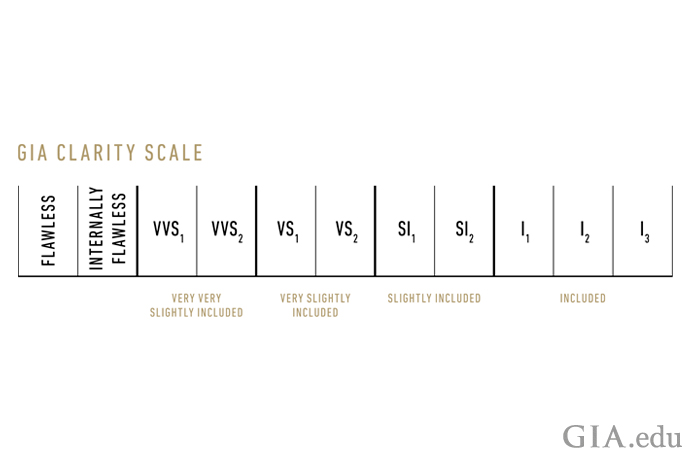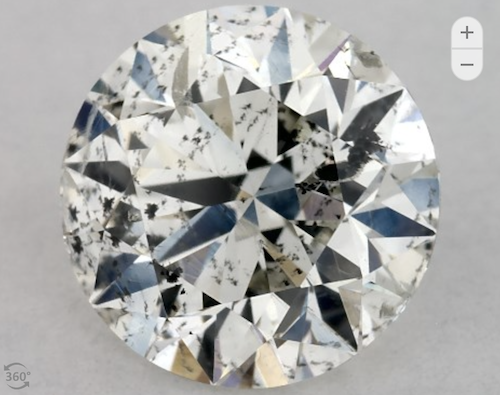Diamond Education
Diamond Clarity
When it comes to buying a diamond, there's more to it than just cut and carat weight. Clarity is a critical component that can significantly impact a diamond's beauty and value. Understanding clarity can not only help you choose a diamond that sparkles brilliantly but also ensures you get the best value for your money.
Clarity refers to the presence of internal or external flaws, known as inclusions and blemishes, respectively. These can range from tiny specks of black carbon to minute cracks or lines. While most of these imperfections aren't visible to the naked eye, they can affect how light is refracted within the diamond, influencing its sparkle and brilliance.
For those who prioritize a wide selection and budget-friendly options, James Allen and Blue Nile offer an extensive range of certified diamonds at various price points. Their cut quality might not match that of Whiteflash, but they're reliable options for finding a beautiful diamond that fits within your budget.
Throughout this guide, we'll delve into the specifics of diamond clarity, helping you understand clarity grades, how clarity affects a diamond's appearance and price, and tips for choosing the right clarity grade. Whether you're a first-time buyer or an experienced shopper, this guide will empower you to make an informed decision on your next diamond purchase.
Summary:
- What is Diamond Clarity?
- Understanding Clarity Grades
- How Clarity Affects a Diamond's Appearance
- Choosing the Right Clarity Grade
- Diamond Clarity and Price
- Tips for Buying Based on Clarity
- Summary and Final Thoughts
- Frequently Asked Questions about Diamond Clarity
What is Diamond Clarity?
Diamond clarity is a term that refers to the absence of inclusions and blemishes. Inclusions are internal flaws or characteristics that occur within the diamond, while blemishes are external flaws on the surface of the diamond. These may include tiny crystals, feathers (small cracks), clouds (groups of tiny inclusions), or cavities (small openings).
While most inclusions and blemishes are too tiny to be seen by the naked eye, they can influence how light interacts with the diamond, affecting its sparkle and brilliance. Furthermore, significant inclusions can impact a diamond's structural integrity.
It's important to note that no diamond is perfectly pure. But the closer it comes to purity, the higher its clarity grade and, consequently, its value.
Remember, while high clarity is desirable, it's only one aspect of a diamond's overall appeal. The best diamond for you will depend on a balance of all the 4Cs—cut, color, carat, and clarity—and your personal preferences and budget.
Understanding Clarity Grades
Diamond clarity is assessed on a scale established by the Gemological Institute of America (GIA), the world's foremost authority on diamonds.

GIA Clarity Chart
This chart comprises six categories, each representing a range of clarity characteristics:
- Flawless (FL): No inclusions or blemishes visible under 10x magnification.
- Internally Flawless (IF): No inclusions visible under 10x magnification, but there might be some slight blemishes.
- Very, Very Slightly Included (VVS1 and VVS2): Inclusions and blemishes are difficult for a skilled grader to see under 10x magnification.
- Very Slightly Included (VS1 and VS2): Minor inclusions and blemishes are somewhat easy to see under 10x magnification.
- Slightly Included (SI1 and SI2): Inclusions and blemishes are noticeable under 10x magnification.
- Included (I1, I2, and I3): Inclusions and/or blemishes are obvious under 10x magnification and may affect transparency and brilliance.
It's important to understand that higher clarity grades don't always mean a more beautiful diamond to the naked eye. Many diamonds with lower clarity grades (such as VS or SI) have inclusions and blemishes that are not visible without magnification, allowing you to potentially save money without compromising on visual beauty.
How Clarity Affects a Diamond's Appearance
Clarity has a direct impact on a diamond's appearance, primarily through its influence on the stone's brilliance. Brilliance, or the total light reflected from a diamond, can be affected by inclusions and blemishes that obstruct the path of light through the diamond.
In general, the more inclusions or blemishes a diamond has, the less brilliantly it might sparkle. Significant inclusions might also be visible to the naked eye, especially in diamonds of higher carat weights or certain shapes that reveal inclusions more readily.

Representation of Diamond Clarity
However, it's important to remember that many diamonds with lower clarity grades (like VS or SI) contain inclusions that are not visible without magnification. In fact, most inclusions can't be seen by the naked eye unless the clarity grade is I1 or lower.
While clarity is important, it's just one aspect of a diamond's appeal. Balance it with the other 4Cs—cut, color, and carat weight—and your personal preferences to find the perfect diamond for you.
Choosing the Right Clarity Grade
Choosing the right clarity grade involves balancing your desire for a diamond that appears flawless to the naked eye with your budget. Here are a few considerations to help you make your decision:
Diamond Size: Larger diamonds have larger facets that can make inclusions more visible. If you're buying a diamond of 1 carat or more, you might want to consider a higher clarity grade.
Diamond Shape: Certain shapes, like Emerald and Asscher cuts, have large, open tables that can make inclusions more visible. Round, Princess, and other brilliant cuts tend to hide inclusions better.
Setting Style: The style of the setting can also influence the clarity grade you should choose. Intricate settings or those with a halo of smaller diamonds may hide inclusions, while simple solitaire settings might expose them.
Budget: Clarity can significantly impact a diamond's price. If budget is a concern, consider choosing a diamond with a lower clarity grade but no eye-visible inclusions.


Choosing the right clarity grade is a personal decision that should be based on your preferences and budget. Remember, the best diamond is not necessarily the one with the highest grades, but the one that makes you happiest.
Diamond Clarity and Price
Diamond clarity is one of the main factors that affect a diamond's price. As a general rule, as clarity increases, so does the price. This is because diamonds with higher clarity grades are rarer, and rarity leads to increased value.
A Flawless diamond, free of any inclusions or blemishes even under 10x magnification, commands the highest prices. On the other end of the spectrum, diamonds with a large number of inclusions or significant blemishes that affect the diamond's appearance, especially if they can be seen with the naked eye, are the least expensive.
However, it's important to note that diamonds of VS (Very Slightly Included) or SI (Slightly Included) grades often have inclusions that can't be seen by the naked eye, making them an excellent choice for budget-conscious buyers. These diamonds offer great value for money as they are significantly less expensive than their Flawless counterparts but still appear clean to the naked eye.
In the end, choosing the right clarity grade is about balancing your personal preferences, budget, and the diamond's overall appearance. The aim should be to find a diamond that delights you, not necessarily the one with the highest clarity grade.
Tips for Buying Based on Clarity
When buying a diamond, clarity is one of the key considerations. Here are some tips to guide your decision based on clarity:
Understand the Clarity Scale: Familiarize yourself with the GIA clarity scale and what each grade means. This will help you understand what you're getting for your money and make a more informed decision.
Eye-Clean is Key: The goal is to find a diamond that appears clean to the naked eye. Diamonds in the VS or SI clarity range often achieve this at a more budget-friendly price point.
Consider Diamond Size and Shape: Larger diamonds and certain shapes, like the Emerald and Asscher cuts, tend to show inclusions more than smaller diamonds or shapes like the Round or Princess cuts.
Use High-Resolution Images and Videos: Use the high-resolution images and 360-degree videos provided by online retailers to closely examine potential diamonds. Look for any visible inclusions or blemishes that might affect your diamond's appearance.
Remember, clarity is just one factor to consider when buying a diamond. The best diamond for you is one that balances all the 4Cs—cut, color, carat, and clarity—along with your personal preferences and budget.
Summary and Final Thoughts
Understanding diamond clarity is crucial when selecting your perfect diamond. Clarity refers to the absence of inclusions and blemishes, and it plays a significant role in a diamond's beauty and value. While higher clarity diamonds are more expensive due to their rarity, many diamonds with lower clarity grades look just as beautiful to the naked eye.
When choosing clarity, consider the diamond's size, shape, and setting style, as well as your personal budget. Remember that the goal isn't to find the diamond with the highest clarity grade, but one that balances clarity with the other 4Cs and meets your personal preferences and budget.
